North America Tea Market Size
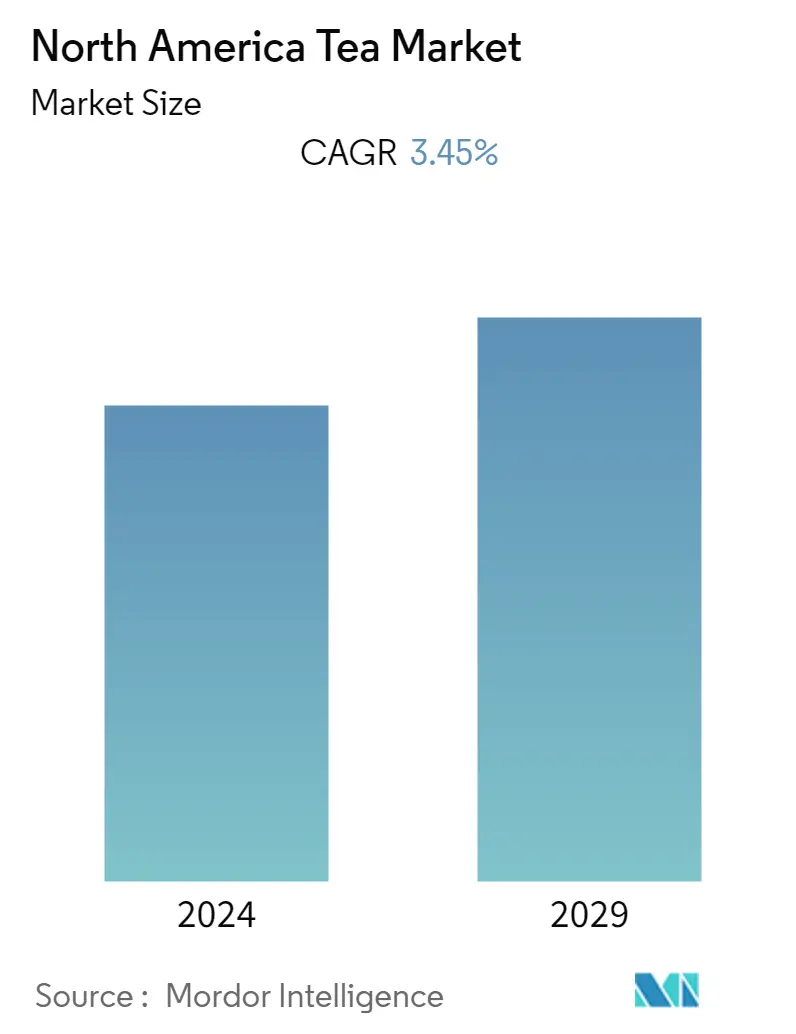
| Study Period | 2019 - 2029 |
| Base Year For Estimation | 2023 |
| Forecast Data Period | 2024 - 2029 |
| Historical Data Period | 2019 - 2022 |
| CAGR | 3.45 % |
| Market Concentration | Low |
Major Players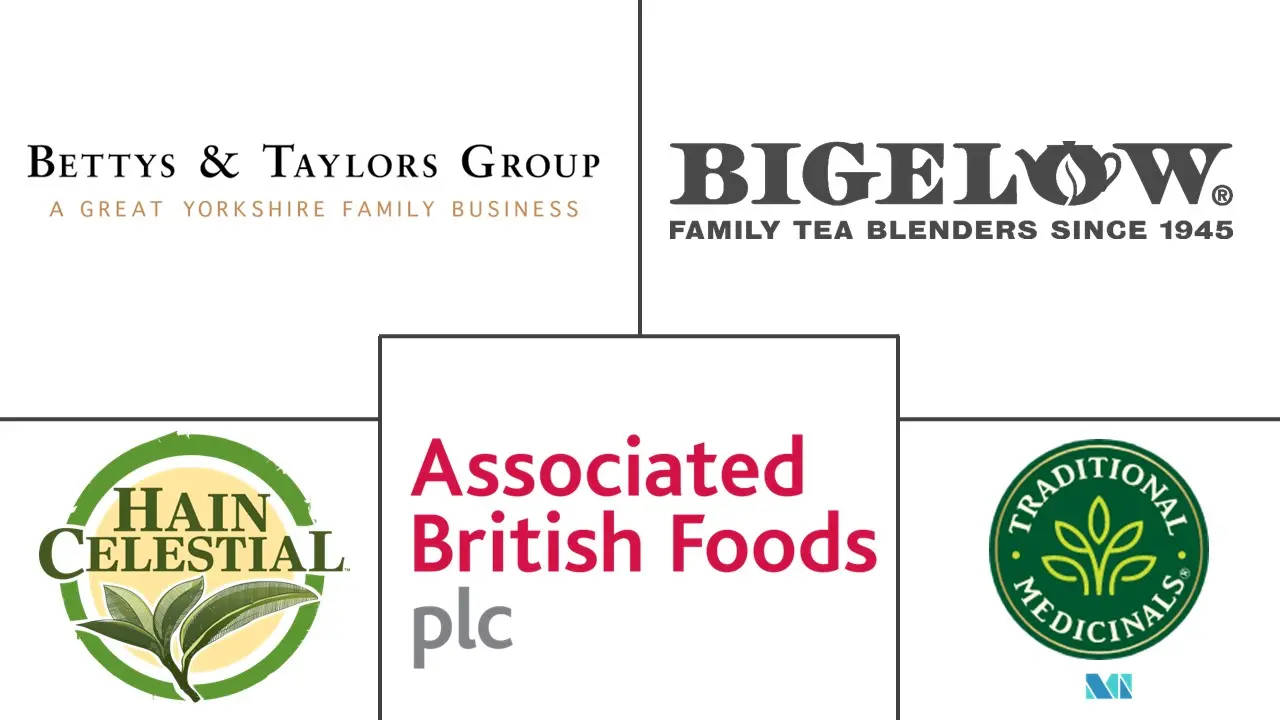
*Disclaimer: Major Players sorted in no particular order |
North America Tea Market Analysis
The North American tea market is projected to register a CAGR of 3.45% in the next five years.
- The perceived health benefits of green tea, herbal tea, and fruit tea are increasing their popularity in the North American market. Hence, the consumption of tea is rising in the region. According to Statistics Canada, the amount of tea available for consumption per person in Canada increased to 82.04 liters in 2021 from 63.69 liters in 2018.
- Additionally, the herbal tea segment is expected to grow significantly over the coming years. As a result of their health benefits, such as improving immunity, the market for herbal teas is increasing in the North American region.
- Moreover, with the rising demand for natural and organic ingredients, consumers are also exploring a diversity of flavors and blends. In addition to higher-quality specialty teas featuring particular flavors, there is a growing interest in higher-quality specialty teas.
- For instance, in February 2021, California-based Numi Organic Tea launched the 'Stay Healthy' Line of functional herbal tea. They recently introduced a line of teas that includes efficacious plants like echinacea, elderberry, dandelion root, Kanna leaf, and burdock root. It contains herbal blends developed to help users relax, support immunity, and combat common cold symptoms.
- The market is witnessing steady growth due to the strong consumer preference in the United States, albeit Canada has been lukewarm in its response. Consumption of tea in the North American region is not limited by seasonality but is always steady, irrespective of time. Canadians have become aware of the health benefits associated with tea consumption and the wide variety of tea offerings, driving the demand for tea during the forecast period.
North America Tea Market Trends
This section covers the major market trends shaping the North America Tea Market according to our research experts:
Healthy Hydration is Propelling the Market Growth
- Tea consumption in North America is driven by consumers' search for new non-alcoholic beverages over fruit juices and carbonated drinks. Consumers are developing an affinity for tea due to its bag version, which offers enhanced convenience, thus, providing a suitable, convenient, and healthy alternative to juices and carbonates.
- Healthy hydration refers to the ability of tea to provide instant refreshment and mild stimulating benefits that are not considered detrimental, which is otherwise the case with coffee and other energy drinks. The organoleptic versatility associated with tea makes it open to manufacturers to innovate alongside the healthy trends that have been resonating more prominently in the North American market.
- The linkage between tea and its healthful properties, such as organic and others, remains fundamentally strong in the North American market. The tea market is propelled due to its health-promoting profile and the variety of herbal variants, new pack sizes, and organic options in North America. The manufacturers are launching their products in the region owing to the rising demand for healthy tea in the region.
- For instance, in June 2022, The UK-based Clipper Tea Company expanded its product range in the United States with new packaging and flavors. The newly added flavors include organic earl grey black tea, organic orange & turmeric herbal tea, organic green tea & lemon, organic winter apple & cinnamon herbal tea, and organic winter berries herbal tea.
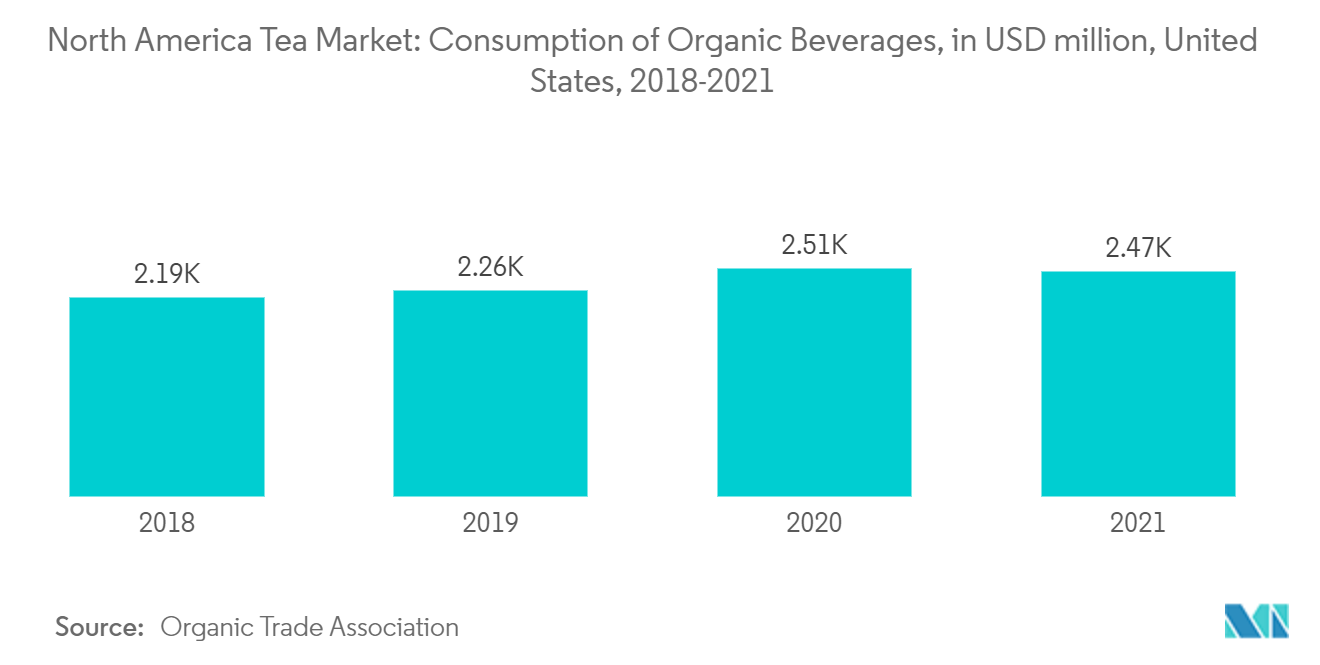
The United States Has the Highest Tea Consumption
- The United States has been identified as the second-largest importer of tea globally. Tea consumption in the United States has increased significantly in the past few years, and tea is now the most popular beverage in this country.
- According to the International Trade Centre Trade Map, in 2021, the top three most valuable import markets for tea were Pakistan (USD 596.5 million), followed by the United States of America (USD 531.8 million), followed by Russia (USD 436.2 million).
- In this region, the major growth opportunities include increasing health awareness among North American consumers, the introduction of new flavors, and the demand for convenience. For instance, in September 2021, in the United States, Old Barrel Tea Company launched three new Mexico-inspired loose-leaf tea blends in three new flavors, hand-crafted in Albuquerque. The latest tea blends include Prickly Pear Green Tea, Pecan Pie Pu Erh Tea, and Horchata Rooibos Tea. Furthermore, in North America, the tea market is primarily driven by rising awareness among the public about the health benefits associated with tea consumption.
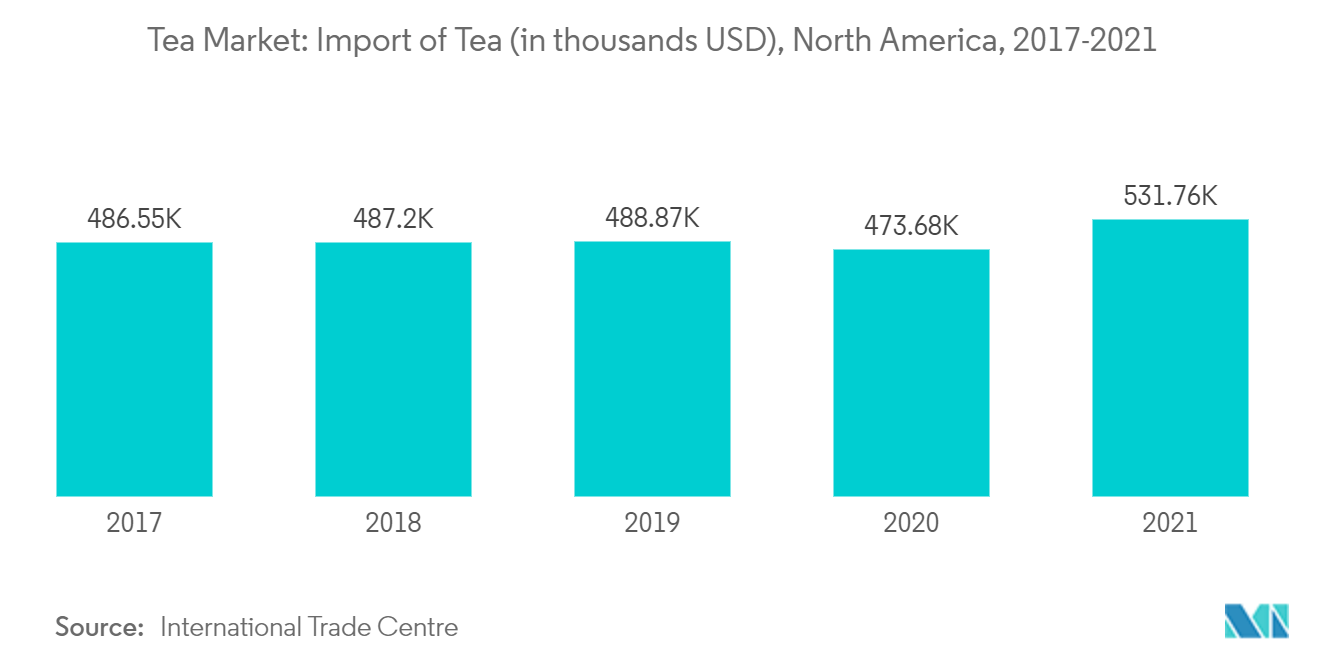
North America Tea Industry Overview
The North American tea market is highly competitive, with regional and global players capturing a significant share of the market. Some of the few companies which have emerged as the leading players are Hain Celestial Group Inc., Bettys & Taylors Group, Associated British Foods PLC, Bigelow Tea Company, and Traditional Medicinals Inc. These players have focused on leveraging opportunities posed by emerging markets to expand their product portfolio, further expanding their market share. Companies compete on different factors, including product offerings, quality, taste, flavours, price, functionality, size, packaging, and marketing/branding activities, to gain a competitive advantage in the market.
North America Tea Market Leaders
-
Hain Celestial Group Inc.
-
Bettys & Taylors Group
-
Associated British Foods PLC
-
Bigelow Tea Company
-
Traditional Medicinals Inc.
*Disclaimer: Major Players sorted in no particular order
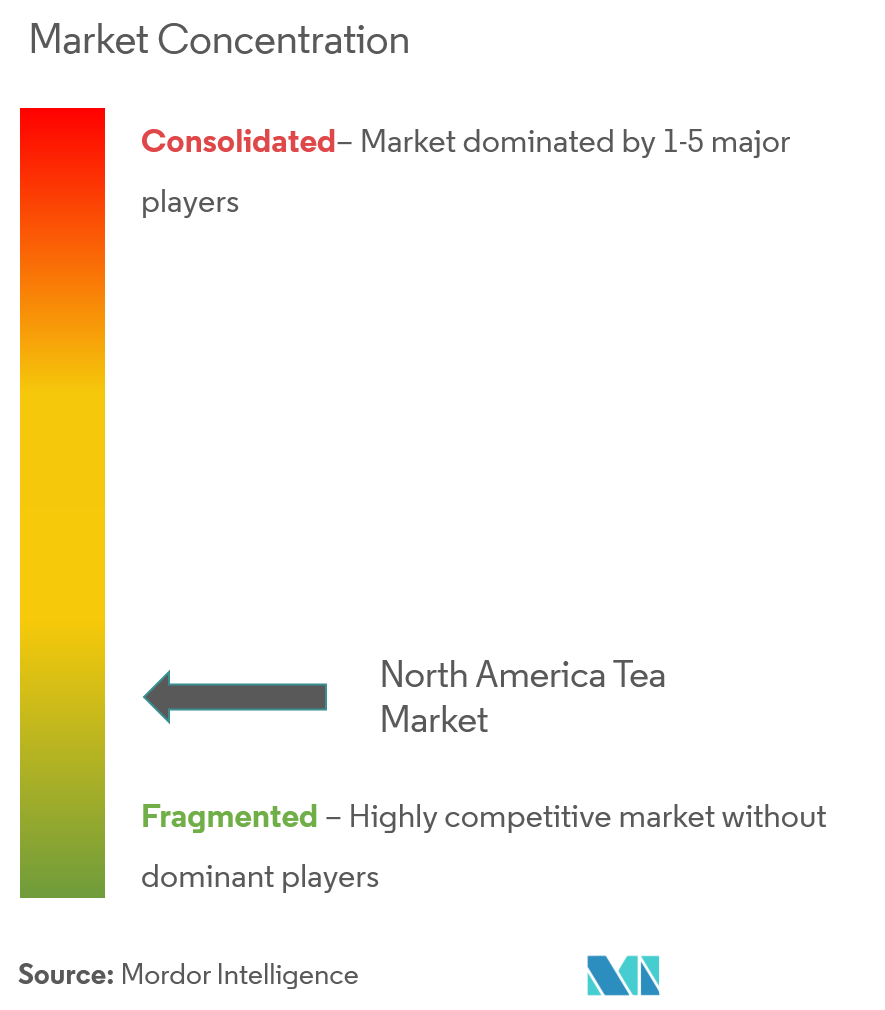
North America Tea Market News
- June 2022: Davids Tea Inc. a leading tea merchant in North America, launched their new blend Manoomin Maple, in partnership with fellow tea company Tea Horse, now available at all 18 DAVIDsTEA flagship stores across Canada and online at davidstea.com.
- May 2022: Tao Tea Leaf opened its latest location in Toronto at Union Station in a high visibility area of the concourse, directly under the Great Hall.
- January 2022: With the addition of its newest watermelon flavor, Red Diamond Coffee and Tea, a key player in the beverage industry, is expanding its line of Simple Sweet Tea for food service operators.
North America Tea Market Report - Table of Contents
1. INTRODUCTION
- 1.1 Study Assumptions and Market Definition
- 1.2 Scope of the Study
2. RESEARCH METHODOLOGY
3. EXECUTIVE SUMMARY
4. MARKET DYNAMICS
- 4.1 Market Drivers
- 4.2 Market Restraints
-
4.3 Porter's Five Forces Analysis
- 4.3.1 Threat of New Entrants
- 4.3.2 Bargaining Power of Buyers/Consumers
- 4.3.3 Bargaining Power of Suppliers
- 4.3.4 Threat of Substitute Products
- 4.3.5 Intensity of Competitive Rivalry
5. MARKET SEGMENTATION
-
5.1 Form
- 5.1.1 Leaf Tea
- 5.1.2 Crush/Tear/Curl Tea
-
5.2 Product Type
- 5.2.1 Black Tea
- 5.2.2 Green Tea
- 5.2.3 Herbal Tea
- 5.2.4 Other Product Types
-
5.3 Distribution Channel
- 5.3.1 Supermarkets/Hypermarkets
- 5.3.2 Convenience Stores
- 5.3.3 Specialist Retailers
- 5.3.4 Online Retail Stores
- 5.3.5 Other Distribution Channels
-
5.4 Geography
- 5.4.1 United States
- 5.4.2 Canada
- 5.4.3 Mexico
- 5.4.4 Rest of North America
6. COMPETITIVE LANDSCAPE
- 6.1 Strategies Adopted by Leading Players
- 6.2 Market Share Analysis
-
6.3 Company Profiles
- 6.3.1 Bettys & Taylors Group
- 6.3.2 Davids Tea Inc.
- 6.3.3 Red Diamond Inc.
- 6.3.4 Associated British Foods PLC
- 6.3.5 Bigelow Tea Company
- 6.3.6 Hain Celestial Group, Inc.
- 6.3.7 William B. Reily and Company, Inc. (Luzianne)
- 6.3.8 Traditional Medicinals Inc.
- 6.3.9 Tata Consumer Products (Tata Tea)
- 6.3.10 CVC Capital Partners (Ekaterra Tea)
- 6.3.11 Tao Tea Leaf
- 6.3.12 Ito En, Ltd.
- *List Not Exhaustive
7. MARKET OPPORTUNITIES AND FUTURE TRENDS
** Subject To AvailablityNorth America Tea Industry Segmentation
Tea is a common beverage made from steeping processed Camellia sinensis leaves along with hot water.
The North American tea market is segmented by form, product type, distribution channel, and geography. Based on form, the market is segmented into leaf tea and CTC (crush, tear, and curl) tea. Based on product type, the market is segmented as black tea, green tea, herbal tea, and other product types. Based on distribution, the market is segmented as supermarkets/hypermarkets, convenience stores, specialist retailers, online retail stores, and other distribution channels. By geography, the market study included leading countries such as the United States, Canada, Mexico, and the Rest of North America.
For each segment, the market sizing and forecasts have been done on the basis of value (in USD million).
| Form | Leaf Tea |
| Crush/Tear/Curl Tea | |
| Product Type | Black Tea |
| Green Tea | |
| Herbal Tea | |
| Other Product Types | |
| Distribution Channel | Supermarkets/Hypermarkets |
| Convenience Stores | |
| Specialist Retailers | |
| Online Retail Stores | |
| Other Distribution Channels | |
| Geography | United States |
| Canada | |
| Mexico | |
| Rest of North America |
North America Tea Market Research FAQs
What is the current North America Tea Market size?
The North America Tea Market is projected to register a CAGR of 3.45% during the forecast period (2024-2029)
Who are the key players in North America Tea Market?
Hain Celestial Group Inc., Bettys & Taylors Group, Associated British Foods PLC, Bigelow Tea Company and Traditional Medicinals Inc. are the major companies operating in the North America Tea Market.
What years does this North America Tea Market cover?
The report covers the North America Tea Market historical market size for years: 2019, 2020, 2021, 2022 and 2023. The report also forecasts the North America Tea Market size for years: 2024, 2025, 2026, 2027, 2028 and 2029.
What are the challenges for new entrants in the North American Tea Market?
The challenges for new entrants in the North America Tea Market are a) Established brands b) Competition
North America Tea Industry Report
The North American organic tea market is experiencing robust growth, driven by increasing consumer awareness of the health benefits associated with green, herbal, and fruit teas. This heightened health consciousness, particularly in regions like Canada and the USA, has spurred demand for teas that offer immunity-boosting properties and other health advantages. The trend towards natural and organic ingredients has further fueled this demand, leading to a diverse array of flavors and blends, especially in premium quality specialty teas that combine health benefits with appealing flavors.
The market is also benefiting from lifestyle trends such as the growing number of tea-related events, which position tea as a healthier hydration choice over sugary drinks. This dynamic market landscape is highly competitive, with players striving for innovation, quality, and effective branding. This competitive environment presents ample opportunities for market expansion.
The burgeoning herbal tea segment and the increasing popularity of organic products are significant contributors to the market's growth. This growth is reflected in various aspects, including market data, market forecast, market growth, and market value. Additionally, the market's segmentation by form, product type, and distribution channel highlights the industry's adaptability to specific consumer preferences.
For a detailed market analysis, including insights on market share and growth prospects, comprehensive reports are available. These reports cover essential aspects such as industry analysis, industry information, industry outlook, industry research, industry sales, industry size, industry statistics, industry trends, market overview, market predictions, market review, market segmentation, and market leaders.
Overall, the North American organic tea market is not only growing but also becoming more segmented, catering to diverse consumer preferences and solidifying the role of tea in the region's beverage culture.



